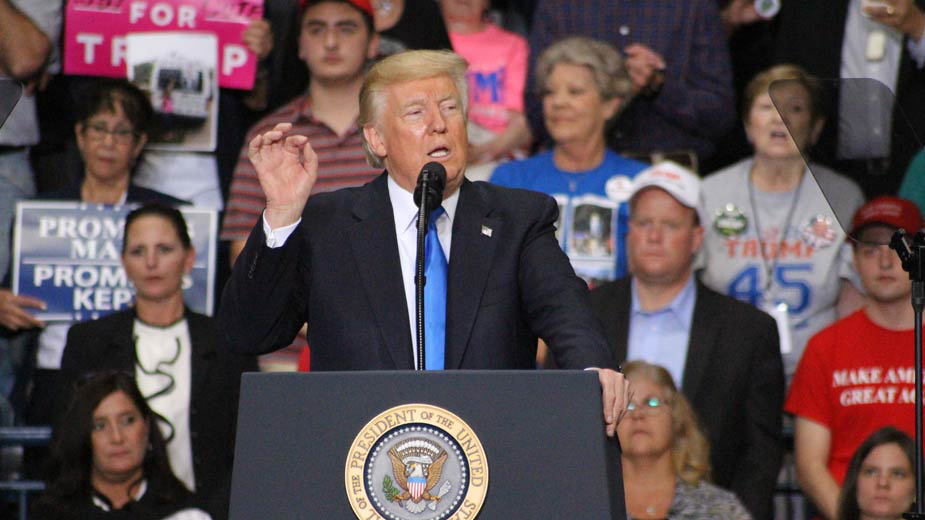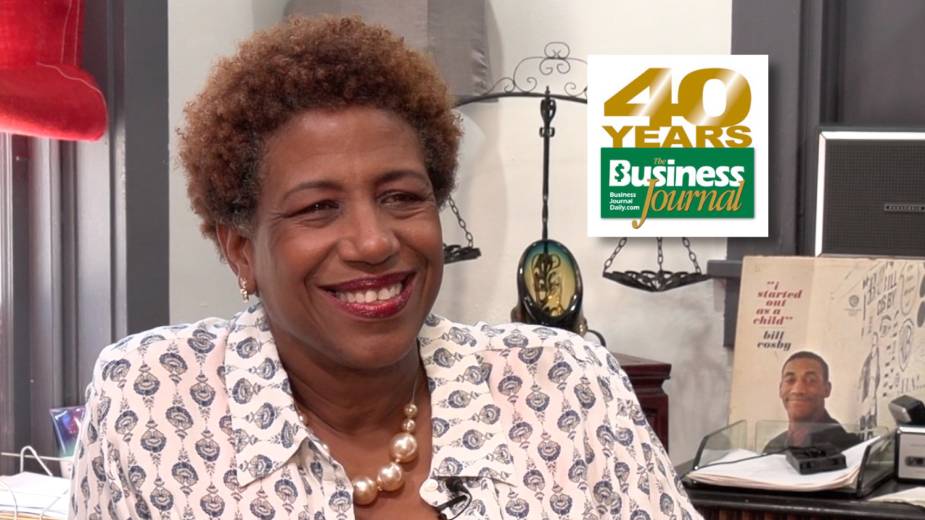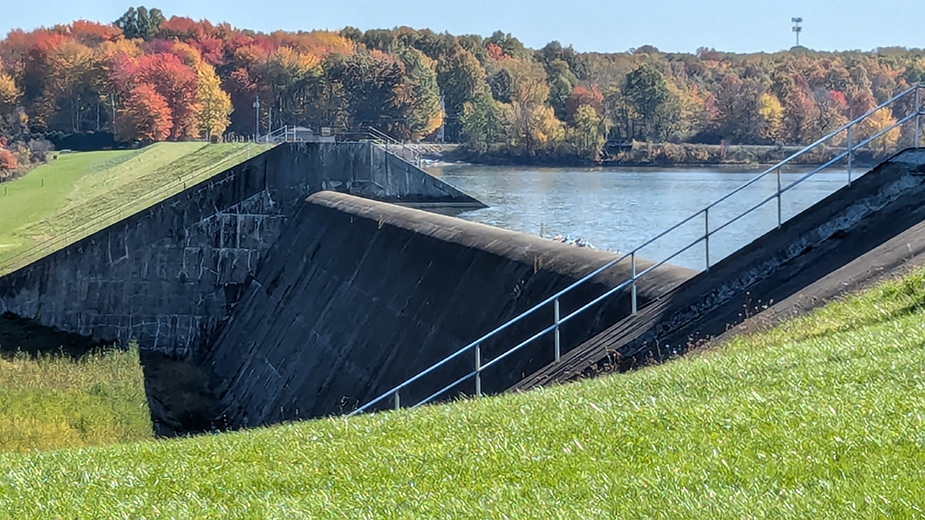Business Journal Classic: From Solidly Blue to Turning Red
YOUNGSTOWN, Ohio – The election of Barack Obama as the nation’s 44th president brought federal resources to the Mahoning Valley that were believed to be key to Youngstown landing a $1 billion economic development project.
Throughout his eight years in office, Obama’s attention to the Mahoning Valley contradicted complaints dating back decades that local voters handed their support to Democrats without getting meaningful dollars in return.
But by the end of Obama’s administration, all his attention proved to be for naught. The ascendency of Donald Trump was transforming the once-solidly Democratic region.
“Welcome to the Republican Mahoning Valley,” YSU political scientist Paul Sracic told Regional Chamber members in November 2020, days after President Trump won here and in Ohio – but not nationwide.
In March 2009, when President Obama first came to Youngstown and brought nearly $20 million in funds for the relocation of a rail line near V&M Star’s existing plant, the Mahoning Valley turning red was not on the horizon. The infrastructure investment was hailed as boosting the city’s chances for landing the project, local officials said. True enough, on Feb. 15, 2010, V&M announced it would move forward with constructing a $1 billion-plus pipe mill.
Obama returned to the area in September 2009 for an event at the General Motors Lordstown Complex. He came again in May 2010 to visit V&M. “A year ago, we took significant action to jumpstart economic growth and job creation,” he said. “That action included making investments with the greatest potential for job growth.”
Neither Obama nor his running mate, Vice President Joe Biden, were strangers to the Mahoning Valley in 2012, when they sought re-election – nor was Obama’s Republican opponent, former Massachusetts Gov. Mitt Romney. Then, Ohio was still a swing state.
Romney spoke the day before Ohio’s March primary at Brilex Taylor Winfield Technologies in Youngstown. The news of that day centered on Romney’s response to a high school senior who asked how his administration would help young people afford college tuition.
“The best thing I can do for you is to tell you to shop around and compare tuition, make sure you get your degree in four years or less, and work hard,” he advised.
In May 2012, Biden spoke at M7 Technologies in Youngstown, where he tore into Romney’s role at a private equity firm that he co-founded. The vice president was joined by an individual left unemployed after Romney’s company had plunged his former employer into bankruptcy, while investors profited.
Obama visited Poland in July 2012, blaming Republican policies for the Great Recession and touring Summer Garden Food Manufacturing Inc. in Boardman.
Next came Romney’s running mate, U.S. Rep. Paul Ryan, who spoke at Youngstown State University Oct. 13, 2012.
Ryan’s stop at a nearby soup kitchen after the event scored unflattering coverage nationally. The visit wasn’t authorized – the organization’s bylaws require it to be apolitical, the organization’s president said. Worse, Ryan and his family arrived after food had been served and the kitchen cleaned, resulting in a photo op of the Ryans rewashing clean dishes.
Obama, scheduled to return to Youngstown for an appearance with former President Bill Clinton in late October 2012, came off the campaign trail to monitor Hurricane Sandy. Instead, Biden joined Clinton for a packed rally at Covelli Centre.
On Nov. 6, 2012, local Democrats celebrated at McMenamy’s Banquet Center in Niles as Ohio’s 18 electoral votes clinched the presidential election for Obama.
The president received approximately the same share of votes in Mahoning and Trumbull counties as he did four year earlier, offering no sign of the political shifts that would come.
In February 2013, skeptics were again disabused of the notion that his administration would forget the region once the election was over. During his State of the Union Address, Obama discussed the new additive manufacturing institute established in Youngstown just a few months earlier – and surprisingly again mentioned Youngstown’s manufacturing hub in 2014.
That year, 2014, former Youngstown Mayor Jay Williams, who had joined the Obama administration in 2011, became the administrator of the U.S. Economic Development Administration. Williams visited Hermitage, Pa., for an October event at the eCenter@LindenPointe and the Youngstown Business Incubator’s Tech Block Building No. 5 in April 2015.
Few people had any inkling of how the 2016 race would be upended by the entry of Trump, a neophyte candidate making his first foray into electoral politics. Local political observers and national analysts alike likened the bombastic New York real estate developer and reality show host’s unfiltered, in-your-face style to that of the late James A. Traficant Jr., who dominated Valley politics for decades.
Trump soon dominated the GOP field, dispatching opponents that included former Florida Gov. Jeb Bush, U.S. Sen. Marco Rubio and, eventually, Ohio Gov. John Kasich.
The Democratic nomination narrowed to a contest between Hillary Clinton and U.S. Sen. Bernie Sanders of Vermont, both of whom would campaign in Youngstown in the lead-up to the March 2016 primary.
Clinton followed her March 12 speech at M7 Technologies with a 10-minute stop – joined by Tim Ryan and his wife – at a downtown Youngstown pub. Speculation swirled for months over whether Ryan, a frequent surrogate for Clinton, would be tapped for a cabinet post.
Sanders spoke at Covelli Centre the day before the primary. That same day, Trump and Kasich made in-person plays for Valley voters, with Kasich at Brilex Industries in the morning and Trump at Youngstown-Warren Regional Airport in the evening.
Although Kasich won Ohio, he lost Mahoning and Trumbull counties to Trump. Clinton won Ohio with support from both counties.
The proximity of the 2016 Republican National Convention, which was expected to bring 50,000 people to Cleveland in July, presented opportunities local officials aimed to seize. The Regional Chamber’s plan included bringing site selectors attending the convention to Youngstown, producing a 300-pound bobblehead of Trump that it would display at the convention, and sending a local delegation to the event. The regional airport planned for an expected increase in traffic but drew fewer flights than expected.
After attending her party’s nominating convention, where Tim Ryan spoke its closing night, Clinton and Tim Kaine campaigned July 30 at East High School, calling her GOP opponent “temperamentally unfit and unqualified” to be president.
Trump’s local appearances over the next few weeks included an Aug. 15 speech at Youngstown State University, where he called for new vetting for immigrants and suspending immigration from areas “that have a history of exporting terrorism.”
Introducing him at the event was Rudy Giuliani, who said in greeting the crowd, “Hello, Indianapolis!”
Campaigning Sept. 1 on behalf of Clinton, Biden addressed workers in Lordstown, and visited the Canfield Fair.
Trump followed up with a Labor Day visit to the Canfield Fair. About 20,000 jammed the fairgrounds to catch a glimpse of Trump, who offered brief remarks and pledged to bring jobs back to Ohio before doing a network television interview.
Former President Clinton spoke Oct. 5 at a union hall in Boardman and mingled with crowds in downtown Youngstown and Niles. Trump’s son Eric addressed supporters at the Mahoning County GOP headquarters Nov. 2, and Sanders led a rally Nov. 3 at YSU to talk up his former rival.
Few were prepared for when news organizations called the election for Trump, who garnered enough electoral votes to win despite losing the popular vote. Mark Munroe, chairman of the Mahoning County GOP, was encouraged by what he had seen in his county, where Trump narrowly lost to Clinton.
“The fact that we had over 6,000 Democrats cross over to support Trump, the fact that we had over 21,000 previously unaffiliated voters who wanted to get involved in the Republican primary, the enthusiasm and the excitement was just off the charts,” Munroe said.
David Betras, then-chairman of the Mahoning County Democratic Party, was among the analysts who appeared on “Why Trump Won,” a CNN special report that aired July 31, 2017, that offered an “outside-D.C. perspective” on the election.
“We knew in March of 2016 that Hillary Clinton was in trouble and that a seismic political shift was taking place. We did our best to warn the experts who were running the campaign, but they chose to ignore us,” Betras said.
The CNN special aired less than a week after Trump held a rally at Covelli Centre, where he boasted that he would bring jobs back to shuttered factories here “or rip ’em down and build brand new ones,” and advised the crowd to not sell their houses.
As events evolved, the GM Lordstown complex became a frequent subject of comments and tweets from Trump. In December 2018, the president said on Fox News that GM’s plans to cease manufacturing vehicles at the plant – announced in late November – “didn’t really matter” because Ohio would “replace those jobs in like two minutes” under his leadership as president.
Trump would later blame organized labor and high union dues for the plant’s closing, including during a March 2019 visit to Lima. That May, Trump touted plans by GM to sell the Lordstown plant to Workhorse Group Inc., an electric vehicle manufacturer.
The Covid-19 pandemic altered all aspects of American life, including the 2020 election. The Mahoning Valley was visited far less often by the campaigns than it had become accustomed to, as health restrictions prevented the mass-congregate events that normally took place.
Still, in June 2020, Vice President Mike Pence helped celebrate the launch of Lordstown Motors’ Endurance EV truck at the former GM plant and shined a spotlight on it during the 2020 Republican National Convention in August. In late September 2020, Trump had a first-hand look at the truck during an event at the White House and praised the EV pickup.
Following his first debate with Trump, Biden stopped briefly at a train station in Alliance, where he spoke to a small, socially distanced audience and fielded reporters’ questions. Sympathizing with the plight of a former GM Lordstown worker who now had to commute to Kentucky for work, he referenced Trump’s remarks in Youngstown three years earlier
“That’s what last night’s debate was about, [what] this whole election’s about: Does your president have any idea or understand what you’re going through and if he does, does he care about it?” Biden asked. “Or does he just ignore you, look down on you, lie to you like this president did, when he told Ohio workers don’t sell your house because no more factories are going to close?”
October included visits to the Valley by Trump’s Environmental Protection Agency administrator, Andrew Wheeler; Housing and Urban Development Secretary Ben Carson; and two of Trump’s children, Donald Trump Jr. and Ivanka Trump.
Trump won Ohio again, taking both Trumbull and Mahoning counties. The election was called for Biden on Nov. 7, 2020.
Trump has since returned to the region twice, to support JD Vance at a September 2022 rally in his successful bid for U.S. Senate, besting Tim Ryan, and again in February 2023, to support East Palestine residents in the wake of the Feb. 3 trail derailment.
Biden finally visited East Palestine on Feb. 16, 2024, more than a year after the derailment. He praised the “herculean” recovery efforts and announcing federal grants to study the short- and long-term effects of the derailment.
The mayor of East Palestine was not impressed. Trent Conway spoke at the Republican National Convention on July 16. “I guess we weren’t their type of folks,” he said of the Democrats. “No Hollywood elites or Wall Street billionaires live in East Palestine. Just hardworking Americans.”
Pictured at top: President Donald Trump speaks at Covelli Centre while campaigning for re-election in 2020.
Copyright 2024 The Business Journal, Youngstown, Ohio.




